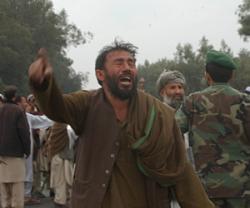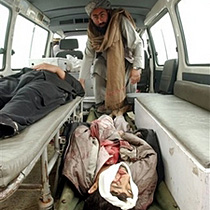By RAHIM FAIEZ
JALALABAD, Afghanistan (AP) - U.S. Marines fleeing a militant ambush Sunday opened fire on civilian cars and pedestrians on a busy highway in eastern Afghanistan, wounded Afghans said. Up to 16 people were killed and 34 wounded in the violence, officials said.

An Afghan man cries as he shouts anti-American slogans after a car bomber attacked an American convoy in Barayekab in Nangarhar province, eastern Afghanistan. (AP Photo/Rahmat Gul)
A suicide attacker detonated an explosives-filled minivan as the American convoy approached, then militant gunmen fired on the troops inside the vehicles, who returned fire, the U.S. military said.
As the Americans sped away, they treated every car and person along the highway as a potential attacker, said Mohammad Khan Katawazi, the district chief of Shinwar. But Maj. William Mitchell, a U.S. military spokesman, said those killed and injured may have been shot by the militants.
More than a half dozen Afghans recuperating from bullet wounds told The Associated Press that the U.S. forces fired indiscriminately along at least a six-mile stretch of one of eastern Afghanistan's busiest highways - a route often filled not only with cars and trucks but Afghans on foot and bicycles.
"They were firing everywhere, and they even opened fire on 14 to 15 vehicles passing on the highway," said Tur Gul, 38, who was standing on the roadside by a gas station and was shot twice in his right hand. "They opened fire on everybody, the ones inside the vehicles and the ones on foot."
The casualty tolls varied widely. The U.S. military said 16 civilians were killed and 24 wounded "during the initial attack." A U.S. soldier was also injured. The incident was under investigation, the military said.
"We certainly believe it's possible that the incoming fire from the ambush was wholly or partly responsible for the civilian casualties," Mitchell said.
Nangarhar provincial health chief Ajmel Pardus said eight people were killed, including a woman and two boys, and 34 were wounded. Four of the wounded were in critical condition, he said.
Interior Ministry spokesman Zemeri Bashary said the chief of the Interior Ministry's criminal division would lead a delegation to Nangarhar province on Monday to investigate. Bashary said it appeared that gunfire from the U.S. soldiers caused most of the casualties.
The gunfire from Americans prompted angry demonstrations in the region - just 30 miles west of the Pakistan border. Hundreds of Afghans blocked the road and threw rocks at police, with some demonstrators shouting "Death to America! Death to Karzai," a reference to President Hamid Karzai.
At the Jalalabad hospital, several victims said the American convoy approached them on the highway and opened fire. As the convoy neared, many cars pulled over to the side of the road, but were still hit by gunfire.
"When we parked our vehicle, when they passed us, they opened fire on our vehicle," said 15-year-old Mohammad Ishaq, who was hit by two bullets, in his left arm and his right ear. "It was a convoy of three American Humvees. All three humvees were firing around."
Ahmed Najib, 23, lay in the next bed, hit by a bullet in his right shoulder.
"One American was in the first vehicle, shouting to stop on the side of the road, and we stopped. The first vehicle did not fire on us, but the second opened fire on our car," Najib said, adding that his 2-year-old brother was grazed by a bullet on his cheek. "I saw them turning and firing in this direction, then turning and firing in that direction. I even saw a farmer shot by the Americans."
NATO and U.S. forces are often accused of firing at Afghan civilians they fear may be about to launch an attack. Though officials say the shootings are done in self defense, they often injure or kill innocent civilians. On Dec. 3, British troops speeding away from a suicide bomb attack in Kandahar city opened fire on cars, killing one civilian and wounding six others.
U.S. forces near Sunday's bombing later deleted photos taken by a freelance photographer working for The Associated Press and video taken by a freelancer working for AP Television News. Neither the photographer nor the cameraman witnessed the suicide attack or the subsequent gunfire. It was not immediately known why the soldiers deleted the photos and videos. The U.S. military didn't immediately comment on the matter.
The freelance photographer, Rahmat Gul, said he took photos of a four-wheel drive vehicle where three Afghans had been shot to death inside.
An American soldier then took Gul's camera and deleted the photos. Gul said he later received permission to take photos from another soldier, but that the first soldier came back and angrily told him to delete the photos again. Gul said the soldier then raised his fist as if he was going to strike Gul.
The U.S. forces involved in the attack and ensuing gunfire were part of the U.S.-led coalition, not NATO's International Security Assistance Force. An official who asked not to be identified said the troops were Marine Special Forces.

An Afghan man stands near two dead bodies of Afghan civilians who were killed by American soldiers after a car bombing on an American convoy in Barayekab in Nangarhar province eastern Afghanistan, Sunday, March 4, 2007. (AP Photo/Rahmat Gul)
A man claiming to speak for Hezb-e-Islami, a group he said is linked with the Taliban, claimed responsibility for the bombing and identified the attacker as an Afghan named Haji Ihsanullah in a telephone call to AP. The spokesman said that the attack was carried out by a breakaway faction of Hezb-e-Islami that was once led by Younis Khalis, a former mujahedeen commander who died last year. The group is now believed to be led by a son of Khalis.
The purported spokesman, who identified himself as Qari Sajjad, said the explosion "destroyed two vehicles, killing or injuring American soldiers." Sajjad said the attack was in revenge for "cruel acts" done to Afghans by U.S. forces.
Lt. Col. David Accetta, a coalition spokesman, said the attack demonstrated the militants' "blatant disregard for human life" by attacking forces in a populated area. NATO officials repeatedly say that suicide bombs aimed at international and Afghan forces kill far more civilians than soldiers.
In southern Afghanistan, meanwhile, two soldiers were killed during a combat operation Saturday, though NATO's International Security Assistance Force did not identify their nationalities or say where the violence happened.
Helmand province, where British troops operate, has seen a number of clashes the last several weeks. Canada also has soldiers in the south, in neighboring Kandahar province.



